Aging is not a payment for reproduction and not the exhaustion of a “resource”
My love don't cost a thing.
Jennifer lopez
One of the ancient hypotheses of the nature of aging postulates that it arises from some limited “resources” of the body, which it can spend either on reproduction or on some other functions aimed at prolonging its life (reparation, for example). That is, roughly speaking, due to some fundamental physical limitation of their resources, organisms can either live long or be fruitful.
What kind of resources the body lacks, supporters of this theory, however, do not specify. Food? Water? Oxygen? No, they say, these are all external resources, with them all the rules, but when turning them into internal ones, something terrible happens that makes us grow old.
')
I will not long harness, I will say at once that this hypothesis of limited resources has been repeatedly refuted. What was the best way to check it out? Yes, just take the animals, and begin to artificially infer from them the long-lived, in the hope that they will fall fertility - because they will need to spend more resources on longevity. What was done in this work . To the surprise of scientists, those flies that began to live longer, and began to multiply more - and they have increased and the overall and early fecundity. That is, their internal resources magically added:
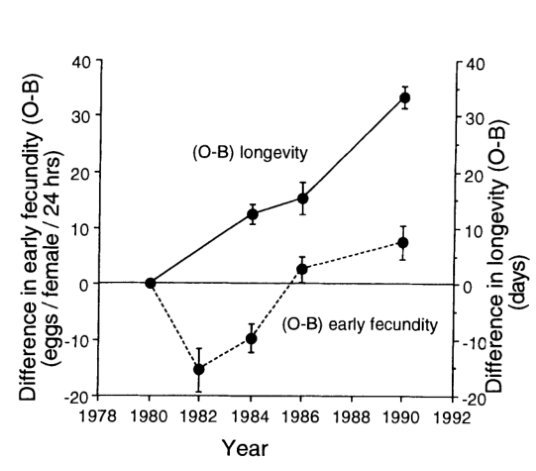
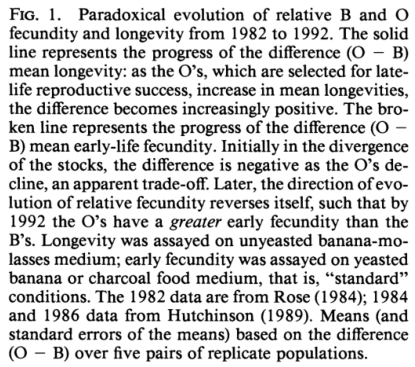
The same thing was shown in other works on different types of flies. Here, scientists have studied as many as a thousand (!) Mediterranean fruit flies and were also surprised to discover the absence of any relationship between fertility and longevity:
The graph below shows this work perfectly, just like a sprinter (65 eggs a day at the peak on the 10th day and 2,000 eggs in a lifetime), and a marathon runner (25 eggs a day at the peak on the 10th day and 500 eggs for all life) have the same RV:

The graph above is just a slice of even steeper 3D graphics from that work, this one:

The guys did not stop at this and studied the patterns of reproduction in 500 more flies, confirming the absence of a trade-off between fertility (early or not early) and life expectancy:
The only correlation between the pancreas and the reproduction they observed was the correlation between the rate of decline in reproduction and aging: the faster the relative (not absolute!) Fertility falls, the earlier the flies die. It does not matter when the fly began to multiply, sooner or later, and what was the average speed of egg laying. The only thing that correlated with the pancreas - the rate of fertility decline. And the researchers themselves say that this is similar to the hours of reproduction, which run at a certain speed proportional to the rate of aging of the body. Whoever ages faster, loses fertility more quickly:
Then one of the aforementioned scientists, James Carey, conducted a study on fruit flies, where he also showed that there is no negative relationship between the fertility pattern (or absolute fecundity) and the pancreas:
Here is a clear demonstration that the fecundity of long-livers only grows (LS is a lifespan, life expectancy). The graph shows the dynamics of laying eggs by flies with a very different prostate - from 20 to 60 days, and we see that the longest-lived fly was also the most prolific:

It would seem, everything is clear, but Lord of the Flies, James Carey, it was impossible to stop! He got into the taste and studied more Mexican flies and also did not find a connection between fertility and longevity:
Well, enough about flies, let's see what our closer relatives have there. And there is also no visible fee for reproduction. Here, the researchers studied 12 species of birds and 18 species of mammals living in zoos, and came to the conclusion that there is no reason to believe that early or general fertility has a negative effect on life expectancy.
And one of the most graphic examples of the absence of resource restrictions are social insects - ants, bees, etc. They have queens and live 10–20 times longer than their fellows, and breed like a machine gun.
Speaking of social animals, it is impossible not to recall the naked diggers , in whom those lucky ones who manage to attain the status of prosecutor, live much longer than their less fortunate relatives. Here is a graph of the survival of the procreators and "losers" of another social African digger, the Zambian digger :
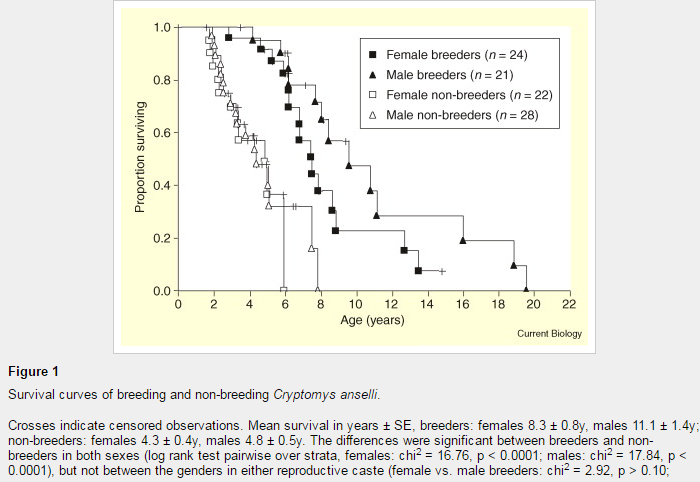
I'm not talking about turtles , whose fertility only grows with age. Or about rabbits :
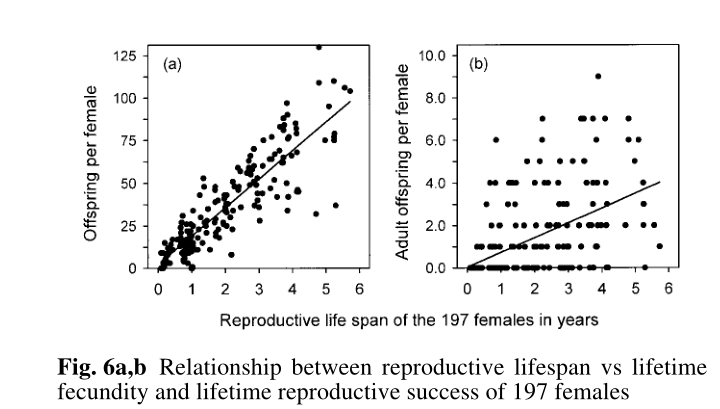
There are other species that are characterized by an increase in fertility with age :
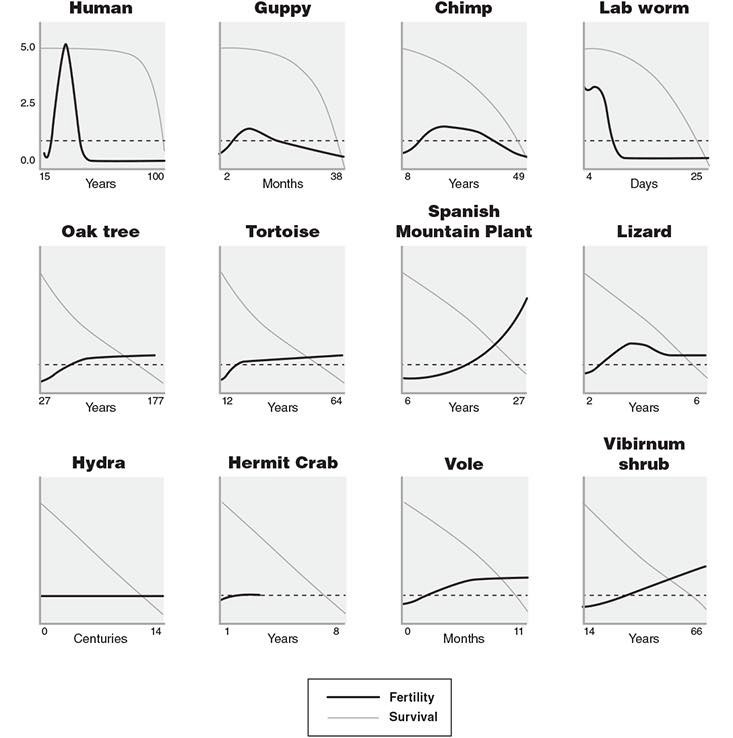
Well, in conclusion, I would say that, fortunately, our beloved women also did not reveal any negative effects of childbearing on life expectancy:

So truly love don't cost a thing .
Jennifer lopez
One of the ancient hypotheses of the nature of aging postulates that it arises from some limited “resources” of the body, which it can spend either on reproduction or on some other functions aimed at prolonging its life (reparation, for example). That is, roughly speaking, due to some fundamental physical limitation of their resources, organisms can either live long or be fruitful.
What kind of resources the body lacks, supporters of this theory, however, do not specify. Food? Water? Oxygen? No, they say, these are all external resources, with them all the rules, but when turning them into internal ones, something terrible happens that makes us grow old.
')
I will not long harness, I will say at once that this hypothesis of limited resources has been repeatedly refuted. What was the best way to check it out? Yes, just take the animals, and begin to artificially infer from them the long-lived, in the hope that they will fall fertility - because they will need to spend more resources on longevity. What was done in this work . To the surprise of scientists, those flies that began to live longer, and began to multiply more - and they have increased and the overall and early fecundity. That is, their internal resources magically added:


The same thing was shown in other works on different types of flies. Here, scientists have studied as many as a thousand (!) Mediterranean fruit flies and were also surprised to discover the absence of any relationship between fertility and longevity:
It is a result of the life expectancy. It is surprisingly that it has been laying on the ground. females that were reproductively less active at young ages. Based on this reasoning, it would be possible to reduce mortality (ie, demographic cost of reproduction; see refs. 20–22).
The graph below shows this work perfectly, just like a sprinter (65 eggs a day at the peak on the 10th day and 2,000 eggs in a lifetime), and a marathon runner (25 eggs a day at the peak on the 10th day and 500 eggs for all life) have the same RV:

The graph above is just a slice of even steeper 3D graphics from that work, this one:

The guys did not stop at this and studied the patterns of reproduction in 500 more flies, confirming the absence of a trade-off between fertility (early or not early) and life expectancy:
... our opinion that there is no direct cost of reproduction. It is the number of eggs produced. For example, it is associated with a longer life span. In contrast, the hypothesis would associate high reproduction rates with shortened life spans.
The only correlation between the pancreas and the reproduction they observed was the correlation between the rate of decline in reproduction and aging: the faster the relative (not absolute!) Fertility falls, the earlier the flies die. It does not matter when the fly began to multiply, sooner or later, and what was the average speed of egg laying. The only thing that correlated with the pancreas - the rate of fertility decline. And the researchers themselves say that this is similar to the hours of reproduction, which run at a certain speed proportional to the rate of aging of the body. Whoever ages faster, loses fertility more quickly:
In particular, our analysis provides for a positive trajectory and subsequent mortality. We have established a relationship to this link. It is quite amazing that our population will be able to reproduce patterns. It’s a good idea to get rid of it. The biological age of human life as contrasted to the chronological age.
Then one of the aforementioned scientists, James Carey, conducted a study on fruit flies, where he also showed that there is no negative relationship between the fertility pattern (or absolute fecundity) and the pancreas:
To find out which parameters are associated with longevity, we take the most long-lived Drosophila, which are in the 10th cluster of flies. It’s surprising that it’s surprising that it’s possible to make it up for a long time to live up to the population of its population, for its reproductive capacity, RC (60.3 ± 5.5 vs 60.47 ± 4.3 eggs / day), 3.6 vs 13 ± 4.2 days).
...
We are not looking for a race span in Drosophila. Only the exponent? -Sen is clearly prolonged senescence. This is a slower effect and a longer life span. In all clusters. This means that longevity in Drosophila is associated with the rate of senescence.
Here is a clear demonstration that the fecundity of long-livers only grows (LS is a lifespan, life expectancy). The graph shows the dynamics of laying eggs by flies with a very different prostate - from 20 to 60 days, and we see that the longest-lived fly was also the most prolific:

It would seem, everything is clear, but Lord of the Flies, James Carey, it was impossible to stop! He got into the taste and studied more Mexican flies and also did not find a connection between fertility and longevity:
[K] now laying the number of eggs during the subsequent one-month period. Thus, it appears that there is no obvious cost of reproduction.
Well, enough about flies, let's see what our closer relatives have there. And there is also no visible fee for reproduction. Here, the researchers studied 12 species of birds and 18 species of mammals living in zoos, and came to the conclusion that there is no reason to believe that early or general fertility has a negative effect on life expectancy.
And one of the most graphic examples of the absence of resource restrictions are social insects - ants, bees, etc. They have queens and live 10–20 times longer than their fellows, and breed like a machine gun.
Speaking of social animals, it is impossible not to recall the naked diggers , in whom those lucky ones who manage to attain the status of prosecutor, live much longer than their less fortunate relatives. Here is a graph of the survival of the procreators and "losers" of another social African digger, the Zambian digger :

I'm not talking about turtles , whose fertility only grows with age. Or about rabbits :

There are other species that are characterized by an increase in fertility with age :

Well, in conclusion, I would say that, fortunately, our beloved women also did not reveal any negative effects of childbearing on life expectancy:

So truly love don't cost a thing .
Source: https://habr.com/ru/post/370575/
All Articles